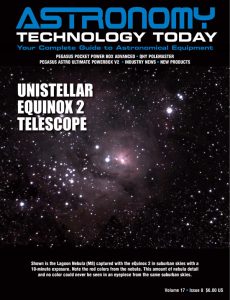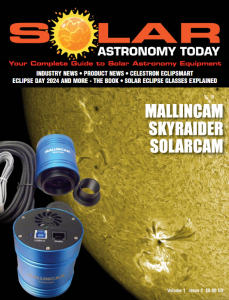The Pegasus Astro Falcon Rotator v2 is the company’s updated large aperture (M68) camera field rotator that offers a lightweight, low-profile design. Despite its slim profile, it possesses the capability to manage and accurately position heavy image trains.
 Highlights of the Falcon Rotator v2 include:
Highlights of the Falcon Rotator v2 include:
– Large Aperture: M68 opening on both sides
– Slim Backfocus: 15.5mm
– De-Rotation support: For Alt-AZ field derotation
– USB-C Connectivity: Single cable for power and data.
– Rotates heavy imaging gear. Up to 6Kg
– Wi-Fi Enabled: Hotspot and Wireless 2.4GHz client support.
– ASCOM Alpaca Support: Immediate integration with popular software.
– Firmware Upgradability: Future-proof with software updates
The rotator offers a powerful geared, low backlash stepper motor that ensures that the rotator will be precisely positioned to the designated degrees. The motor has been strategically positioned away from the optical axis to ensure it does not interfere with equipment.
The Pegasus Astro Falcon Rotator v2 has a low profile, slim 15.5mm backfocus thickness and features openings on both sides with an M68 (2.67 inches) x 1mm pitch thread. It has been tested at 6Kg (13.2lbs) of imaging setup.
The rotator can be connected with a USB-C cable for both power and data, reducing complexity in your telescope setup. Additionally, it’s Wi-Fi enabled, allowing you to control your field rotation remotely from your mobile phone.
Operating the rotator is a seamless experience, thanks to its compatibility with classic ASCOM, native ASCOM Alpaca drivers and the Pegasus Astro Unity Platform software. This user-friendly design simplifies the process of automatically and precisely orienting your camera field, making your astrophotography sessions convenient and efficient.
The rotator has the mechanical precision to achieve field de-rotation. The supplied Unity Platform software calculates rate of rotation (RoR) based on the site latitude, target altitude and azimuth position. By fine-tuning the micro-step drive control of the motor, derotation can achieve a resolution as precise as 5 arc-seconds.
The use of the ASCOM Alpaca offers many benefits over classic ASCOM drivers with its platform independence, modern web standards, streamlined installation, remote control capabilities, extensibility, and open-source options. This ensures superior compatibility and user-friendly performance.
The Falcon Rotator v2 comes equipped with an integrated web server that communicates with Alpaca clients natively. This integration enhances the user experience by providing easy access to image-rotation control through ASCOM Alpaca but also monitoring from any device with a web browser such as a smart phone. The rotator offers a nice cable wrap/snag prevention feature that does not allow a clockwise turn above 220 degrees.
The Pegasus Astro Falcon Rotator v2 specifications include:
– Dimensions: 180mm x 140mm x 56mm
– Material: Anodized Aluminum
– Clear Aperture: M68/1mm pitch thread
– Steps per degree: Supports micro-stepping (x2,4,8,16,32)
– Payload: 6Kg /13.2lbs
– Telescope Side: M68 Opening
– Camera Side: M68
– Back Focus: 15.5mm
– Weight: 0.7Kg/1.54lbs)
– Connectivity: USB 2.0 with USB-C
– Operating Power: 5V, 0.9A
You can learn more about the Pegasus Astro Falcon Rotator v2 here.

 And to make it easier for you to get the most extensive news, articles and reviews that are only available in the magazine pages of Astronomy Technology Today, we are offering a 1-year magazine subscription for only $6! Or, for an even better deal, we are offering 2 years for only $9. Click here to get these deals which only will be available for a very limited time. You can also check out a free sample issue here.
And to make it easier for you to get the most extensive news, articles and reviews that are only available in the magazine pages of Astronomy Technology Today, we are offering a 1-year magazine subscription for only $6! Or, for an even better deal, we are offering 2 years for only $9. Click here to get these deals which only will be available for a very limited time. You can also check out a free sample issue here.
The Sun is more active than it’s been in years and if that’s not enough, we have the upcoming Total Solar Eclipse on April 8, 2024! If you’d like to learn more about the technology behind solar observing, solar imaging and more, you can check out our new monthly magazine – Solar Astronomy Today. It’s free to read, no subscription needed and available here. And if you are preparing for the upcoming eclipses and want to know your equipment options from solar glasses to the most out of this world solar viewing and imaging options, check out our free publication – The Definitive Guide to Viewing and Imaging the Sun – simply click here and enjoy reading!

